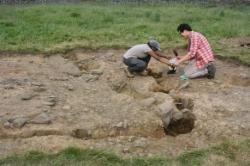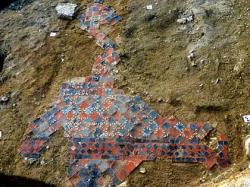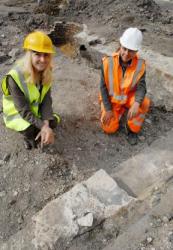INSTITUT SUPERIEUR D'ANTHROPOLOGIE
INSTITUTE OF ANTHROPOLOGY
ONLINE COURSES / COURS A DISTANCE
SUMMER TERM : JULY 2014
REGISTER NOW
ROYAUME UNI –  Yarnbury Henge - A group of archaeology students have discovered the remains of the oldest wooden house so far found in the Dales - and used by its earliest farmers. The timber structure, unveiled at Yarnbury Henge near Grassington, dates from almost 6,000 years ago, a time when agriculture in Britain was in its infancy.The Bradford University students uncovered the house as part of a dig at the Henge which has been going on for almost three weeks. Alex Gibson, reader in British Prehistory at the university, who is leading the dig, said the discovery was "very exciting and very significant." He explained: "It's a rectangular timber structure and similar remains found elsewhere in Britain gives us a fairly precise chronological window - we can pinpoint it to around 3,800BC. Farming in Britain started around 4,000BC, so these remains relate to the first farming in the Dales.
Yarnbury Henge - A group of archaeology students have discovered the remains of the oldest wooden house so far found in the Dales - and used by its earliest farmers. The timber structure, unveiled at Yarnbury Henge near Grassington, dates from almost 6,000 years ago, a time when agriculture in Britain was in its infancy.The Bradford University students uncovered the house as part of a dig at the Henge which has been going on for almost three weeks. Alex Gibson, reader in British Prehistory at the university, who is leading the dig, said the discovery was "very exciting and very significant." He explained: "It's a rectangular timber structure and similar remains found elsewhere in Britain gives us a fairly precise chronological window - we can pinpoint it to around 3,800BC. Farming in Britain started around 4,000BC, so these remains relate to the first farming in the Dales.
http://www.cravenherald.co.uk/news/11301773.Archaeology_students_find_6_000_year_old_house_remains_at_Yarnbury_henge__Grassington/
INDE –  New Dehli -The shifting of the Archaeological Survey of India’s Delhi Circle Office from the Safdarjung Tomb is part of larger shifting of offices out of historic monuments .The ASI shifted from its office on the southern side of the tomb to the General Pool Offices complex near the Indian National Army (INA) Colony between July 6 and 9. The office was housed at the tomb since 1972, when the Delhi Circle was carved out of the erstwhile Northern Circle based in Dehradun. The reference library, which boasts 12,000 tomes in the ramparts of the tomb, is also being moved to the new venue..
New Dehli -The shifting of the Archaeological Survey of India’s Delhi Circle Office from the Safdarjung Tomb is part of larger shifting of offices out of historic monuments .The ASI shifted from its office on the southern side of the tomb to the General Pool Offices complex near the Indian National Army (INA) Colony between July 6 and 9. The office was housed at the tomb since 1972, when the Delhi Circle was carved out of the erstwhile Northern Circle based in Dehradun. The reference library, which boasts 12,000 tomes in the ramparts of the tomb, is also being moved to the new venue..
http://www.thehindu.com/news/cities/Delhi/shifting-of-asi-office-from-safdarjung-tomb-part-of-a-larger-move/article6154212.ece
ROYAUME UNI –  Petersfield - A four-year campaign to dig a 21-barrow set of graves, declared as a set of Scheduled Ancient Monuments and aligned in a style linked to Stonehenge, has begun at one of Britain's largest and most intriguing mixed cemeteries. Archaeologists hope to discover the origins of the cemetery on Petersfield Heath, where the early Bronze Age burial mounds are set in a style more typically associated with Wessex. The style of the burial mounds is more commonly seen is Avebury, Stonehenge and Wessex. The build, environmental impact, social implications and living conditions of the barrows will be examined in a series of dig seasons expected to begin in September.
Petersfield - A four-year campaign to dig a 21-barrow set of graves, declared as a set of Scheduled Ancient Monuments and aligned in a style linked to Stonehenge, has begun at one of Britain's largest and most intriguing mixed cemeteries. Archaeologists hope to discover the origins of the cemetery on Petersfield Heath, where the early Bronze Age burial mounds are set in a style more typically associated with Wessex. The style of the burial mounds is more commonly seen is Avebury, Stonehenge and Wessex. The build, environmental impact, social implications and living conditions of the barrows will be examined in a series of dig seasons expected to begin in September.
http://www.culture24.org.uk/history-and-heritage/archaeology/art488124-Archaeologists-excavating-Bronze-Age-cemetery-Hampshire
TURQUIE –  Asmara - The remains of a Roman temple have been discovered during drilling for the construction of a school in the northern province of Bartın’s Amasra district. The construction process has been stopped and the school will now be constructed elsewhere. Archaeological excavations will soon start over an area of 3,000 square meters in order to reveal the ancient settlement. Amasra Museum Director Baran Aydın said a column heading, pedestals and the marble ground of the temple had been uncovered. “We estimate that that temple dates back to the Roman era. You can find works from the Roman and Byzantine eras everywhere in Amasra. During one-month-long preliminary works, we found data that may be very important for the district. The first findings show that the temple collapsed during an earthquake. Further works might reveal the ancient city under the district,” Aydın said.
Asmara - The remains of a Roman temple have been discovered during drilling for the construction of a school in the northern province of Bartın’s Amasra district. The construction process has been stopped and the school will now be constructed elsewhere. Archaeological excavations will soon start over an area of 3,000 square meters in order to reveal the ancient settlement. Amasra Museum Director Baran Aydın said a column heading, pedestals and the marble ground of the temple had been uncovered. “We estimate that that temple dates back to the Roman era. You can find works from the Roman and Byzantine eras everywhere in Amasra. During one-month-long preliminary works, we found data that may be very important for the district. The first findings show that the temple collapsed during an earthquake. Further works might reveal the ancient city under the district,” Aydın said.
http://www.hurriyetdailynews.com/roman-temples-remains-found-during-construction-in-black-sea-province-.aspx?pageID=238&nID=68314&NewsCatID=375
ROYAUME UNI –  Dudley - History has been coming to life in Dudley as an archaeology team unearths secrets from the town’s past. The redevelopment of the market place in the central shopping area has given archaeologists the chance to explore the remains of buildings known as Middle Row, which were demolished in the mid-19th century. Excavations have shown the buildings in the town centre were constructed from limestone. A material commonly used in Dudley from the 17th century.
Dudley - History has been coming to life in Dudley as an archaeology team unearths secrets from the town’s past. The redevelopment of the market place in the central shopping area has given archaeologists the chance to explore the remains of buildings known as Middle Row, which were demolished in the mid-19th century. Excavations have shown the buildings in the town centre were constructed from limestone. A material commonly used in Dudley from the 17th century.
http://www.dudleynews.co.uk/news/local/11300505.History_comes_to_life_in_Dudley_town_centre_dig/?ref=var_0
GHANA – Komaland - Mr Samuel Nkumbaan, a lecture at the Department of Archaeology at the University of Ghana, has stated that the research of Koma land, a village in the West Mamprusi District in the Northern part of Ghana, will help investigate aspects of material cultures of Tando and its relationship with material culture from other sites within the Koma-land archaeological region. According to him, a datum point was located and sampling units were identified. These units were evenly arranged along eight (8) radiating transect lines positioned at angles of 45 degrees. Mr Nkumbaan said this at the launch of Fragmentary Ancestors from the Koma land in Accra. The team did indeed collect artefacts (terracotta figurines, tobacco pipes, stone implements and potsherds) and recorded features (mounds) with a GPS unit. Mr Nkumbaan stated that the previous archaeological studies in the village of Yikpabongo, 9km north-west of Tando, had brought to light two forms of mounds.
http://www.ghana.gov.gh/index.php/2012-02-08-08-32-47/general-news/5905-figurines-and-archaeology-from-koma-land-launched